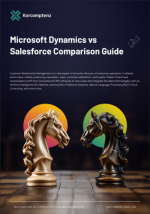
Salesforce and Microsoft Dynamics 365 are two of the most dominant forces in the customer relationship management (CRM) software market, and for good reason. Both companies played a critical role in shaping the modern CRM landscape—Salesforce as a trailblazing cloud-based platform born from Silicon Valley’s dot-com era, and Microsoft Dynamics 365 as a robust offering from one of the world’s most valuable and established technology companies. Today, both platforms provide businesses of all sizes with highly regarded CRM solutions that go beyond simple contact management, offering sophisticated tools for lead scoring, pipeline management, sales forecasting, customer service, and marketing automation. Their flexibility allows organizations to scale and customize features to meet a wide range of business needs, whether it’s tracking sales performance, managing customer cases, or streamlining operations across departments. In this in-depth breakdown of Microsoft Dynamics vs. Salesforce, we’ll dive into key aspects like usability, features, pricing, integrations, and overall pros and cons—giving you the insights you need to make an informed decision about which CRM solution aligns best with your company’s goals and resources.
Content provided by Korcomptenz
